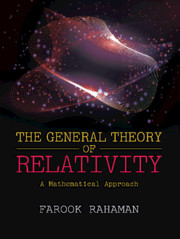Book contents
- Frontmatter
- Dedication
- Contents
- List of Figures
- List of Tables
- Preface
- Acknowledgments
- Chapter 1 Tensor Calculus — A Brief Overview
- Chapter 2 Geodesic
- Chapter 3 Einstein Field Equations
- Chapter 4 Linearized Gravity
- Chapter 5 Lie Derivatives and Killing’s Equation
- Chapter 6 Spacetimes of Spherically Symmetric Distribution of Matter and Black Holes
- Chapter 7 Particle and Photon Orbits in the Schwarzschild Spacetime
- Chapter 8 Causal Structure of Spacetime
- Chapter 9 Exact Solutions of Einstein Equations and Their Causal Structures
- Chapter 10 Rotating Black Holes
- Chapter 11 Elementary Cosmology
- Chapter 12 Elementary Astrophysics
- Appendix A Extrinsic Curvature or Second Fundamental Form
- Appendix B Lagrangian Formulation of General Relativity
- Appendix C 3+1 Decomposition
- Bibliography
- Index
Chapter 6 - Spacetimes of Spherically Symmetric Distribution of Matter and Black Holes
Published online by Cambridge University Press: 24 March 2021
- Frontmatter
- Dedication
- Contents
- List of Figures
- List of Tables
- Preface
- Acknowledgments
- Chapter 1 Tensor Calculus — A Brief Overview
- Chapter 2 Geodesic
- Chapter 3 Einstein Field Equations
- Chapter 4 Linearized Gravity
- Chapter 5 Lie Derivatives and Killing’s Equation
- Chapter 6 Spacetimes of Spherically Symmetric Distribution of Matter and Black Holes
- Chapter 7 Particle and Photon Orbits in the Schwarzschild Spacetime
- Chapter 8 Causal Structure of Spacetime
- Chapter 9 Exact Solutions of Einstein Equations and Their Causal Structures
- Chapter 10 Rotating Black Holes
- Chapter 11 Elementary Cosmology
- Chapter 12 Elementary Astrophysics
- Appendix A Extrinsic Curvature or Second Fundamental Form
- Appendix B Lagrangian Formulation of General Relativity
- Appendix C 3+1 Decomposition
- Bibliography
- Index
Summary
Spherically Symmetric Line Element
Spherically symmetric means an invariance under any arbitrary rotation of axes at a particular point, called the center of symmetry. Using θ and ϕ (polar coordinates) and choosing the center of symmetry at origin, we have the general form of the line element with spherical symmetry.
For the surfaces r = constant and t = constant, the line elements reduces to form two spheres on which a typical point is labeled by coordinate θ and ϕ and line element takes the form
This spherical symmetric line element is invariant when θ and ϕ are varied. The center of symmetry is the point O, which is given by r = 0.
Now we introduce new coordinates by the transformations:
where the function K will be chosen later.
From the above transformation equations, we have
Then the line element becomes
Now we choose K such that coefficient of dr′dt′ is zero.
Thus, we have
Hence we get general line element on
where σ, ω, and μ are functions of r′ and t′.
Now we take another transformation,
where q is so chosen that the coefficient of dR dT in ds2 is zero.
Thus, finally, we get the line element
where 𝜈 and μ are functions of R and T.
Note 6.1
Here R coordinate has specific significance:
The area of the surface of the sphere, R = constant is given by A = 4πR2.
Three volume of the sphere with radius R
e.g., for eμ = (1 - ar2)2, one can get
For the four-dimensional tube that is bounded by the sphere with radius R and two planes, t = constant, separated by a time T, the four volume is
e.g., for eμ = e𝜈 = (1 - ar2)2, one can get
Schwarzschild Solution or Exterior Solution
The exact solution of the Einstein field equation in empty space was obtained by Schwarzschild in 1916, which describes the geometry of spacetime outside a spherically symmetric distribution of matter.
Consider the metric of the empty spacetime outside of a spherically symmetric distribution of matter of mass M as
- Type
- Chapter
- Information
- The General Theory of RelativityA Mathematical Approach, pp. 115 - 158Publisher: Cambridge University PressPrint publication year: 2021



